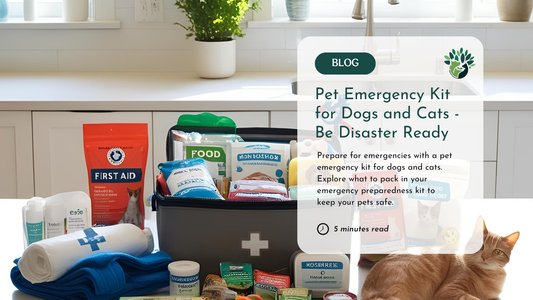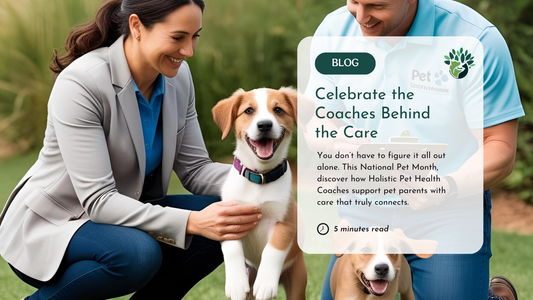Every year, natural disasters catch families off guard—but for pet owners, the risk is doubled. If you're not prepared, your beloved animal companion could be left vulnerable during an evacuation or emergency situation. That’s why May 8 is recognized as National Animal Disaster Preparedness Day, a reminder to include dogs and cats in your emergency plans before disaster strikes.
This annual awareness day emphasize that when disaster hits, your animals depend entirely on you for safety. Whether it's a flood, wildfire, tornado, or power outage, a few proactive steps can make all the difference.
Emergency Preparedness Basics for Pet Owners
Emergencies can happen when we least expect them—natural disasters, power outages, or sudden evacuations. As a pet parent, being prepared isn't just about stocking up on essentials for yourself; it's about making sure your furry family members are protected too. In this guide, we’ll walk you through the basic steps of emergency preparedness, so you can act quickly and confidently when it matters most.
1. Create a Pet Emergency Kit

Just like humans need a go-bag, your animals do too. Dogs and cats have different needs, so assembling an emergency kit for dogs and a separate emergency kit for cats ensures they both get the care and comfort they need during a crisis. Your emergency preparedness kit for pets should include:
-
Food and water (3 to 7 days' worth)
-
Medications and Supplements
-
Leash, harness, and carrier
-
Waste bags and litter
-
A favorite toy or blanket for comfort
-
Veterinary records and ID photos
Place each emergency kit for dogs and emergency kit for cats in waterproof bags and store them near your own emergency supplies so you can grab and go.
2. Make Sure Your Pet Has ID
In the chaos of an emergency, pets can get lost. Ensure your dog or cat wears a collar with up-to-date ID tags and consider microchipping. If your pet is already microchipped, double-check that your contact information is registered and current.
3. Plan an Evacuation Strategy That Includes Pets
Never assume you'll be able to find a last-minute solution. Research pet-friendly shelters, hotels, or boarding facilities ahead of time. Make a list and keep it with your emergency contacts.
4. Use a Pet Alert Sticker
Place a pet alert sticker on your front door or window. It tells first responders how many pets are inside in case you're not home during an evacuation. You can order these stickers online or get them at your vet's office.
5. Keep Copies of Medical and Vaccination Records
In a disaster, you may need to board your pet or seek veterinary care in another area. Having printed copies (and digital backups) of vaccination and medical records will save time and stress.
6. Practice Evacuation Drills With Your Pet
Pets can sense stress, and unfamiliar routines may frighten them. Practice loading them into a crate or car quickly so they're less anxious if a real evacuation is needed. Reward them with treats and calm praise.
7. Stay Informed and Act Early
Sign up for weather alerts in your area and monitor updates from local emergency services. Don’t wait for mandatory evacuations; leaving early gives you more time to calmly relocate your pet and reduces the risk of injury or loss.
🌀Emergency Preparedness Kit For Pet for Tornado Season
If you live in the U.S. Midwest or South, tornado season—which typically peaks from April through June—poses a fast-moving and often unpredictable threat. When a tornado warning hits, there may be only minutes to act. Here's how to make sure your pets are protected when every second counts:
1. Designate a Safe Shelter Area for You and Your Pets
Identify the safest location in your home, such as a basement, interior bathroom, or closet on the lowest level, away from windows. Make sure it's large enough to accommodate both your family and your pets.
2. Keep Your Pet Emergency Kit Nearby
Have your pet’s emergency preparedness kit (leash, crate, food, water, medications) stored in or near the shelter area. In a tornado scenario, there's no time to search for scattered items—being prepared saves lives.
3. Use a Crate or Carrier During Shelter-in-Place
Pets may panic during the high winds and pressure changes. A secure crate helps keep them safe and contained, reducing the risk of injury or escape during the storm.
4. Microchip and ID Your Pets
Tornadoes can destroy fences, blow open doors, and separate pets from their families. Make sure your pet is microchipped or wears an up-to-date ID tag to increase the chances of being reunited if you’re separated.
5. Practice Shelter Drills With Your Pet
Familiarize your pet with your safe room ahead of time. Practice leading them there quickly, using calm voice cues and treats. In a real emergency, this reduces fear-based resistance.
6. Have a Post-Storm Plan
Keep your pet leashed or crated after the storm. Debris, downed power lines, and broken fences can make even your yard dangerous. Inspect everything before allowing them to roam freely.
Support Products That May Help in an Emergency
Emergency preparedness goes beyond food and first-aid supplies—it also includes supporting your pet’s body and mind during high-stress situations. Calming products with ingredients like L-theanine, chamomile, or medicinal mushrooms can help ease nervousness during storms, evacuations, or travel. At the same time, immune and liver-supporting blends may help pets cope with the physical strain of stress, environmental toxins, or disrupted routines. Whether your pet tends to get anxious during loud weather or needs extra recovery support, there are gentle, holistic options to help maintain balance.
Stress can take a toll on your pet’s whole system—affecting digestion, immunity, and overall comfort. Having the right supportive products on hand can make a real difference in how your pet weathers an emergency. Want to know exactly what to include in your kit? Check out our full guide on what to keep in your pet’s emergency kit »
Final Thought
Your pet is family—and they rely on you in every emergency. This National Animal Disaster Preparedness Day, take a few minutes to review your plan, check your supplies, and talk to your household about pet safety. Being ready isn't just responsible—it's lifesaving. Whether you're building an emergency kit for dogs, curating an emergency kit for cats, or starting from scratch with an all-in-one emergency preparedness kit for pets, the time to act is now—not when the storm hits.















